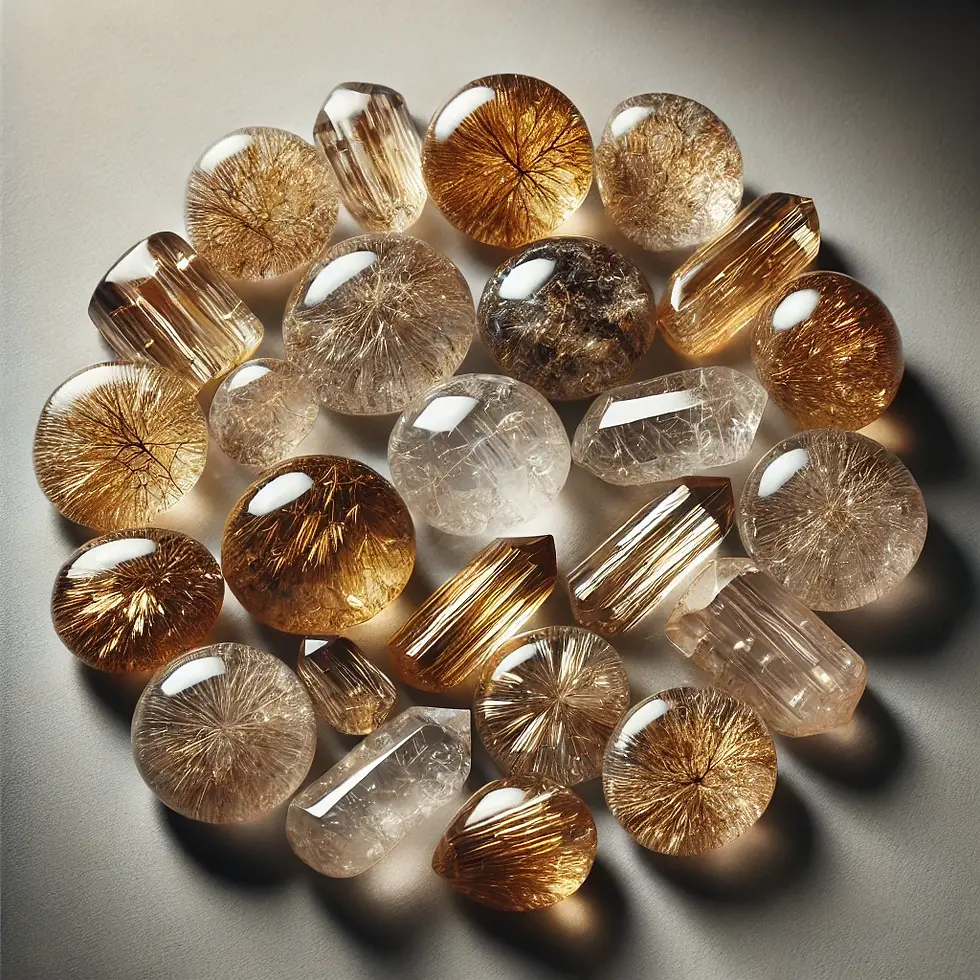
Rutile is a captivating mineral known for its striking needle-like crystals and remarkable optical properties. Composed primarily of titanium dioxide, Rutile is most commonly recognized for its golden or reddish-brown hues, though it can occur in a variety of colors including red, yellow, and even black. First described in 1803 by Abraham Gottlob Werner, Rutile derives its name from the Latin "rutilus," meaning "red," reflecting the deep red color often observed in some specimens.
Rutile is perhaps best known for its presence as inclusions within other minerals, particularly quartz, creating the highly prized Rutilated Quartz. These golden, hair-like inclusions are often referred to as "Venus Hair Stone" or "Angel Hair Stone," adding a mesmerizing beauty to their host crystals. Beyond its aesthetic appeal, Rutile boasts one of the highest refractive indices of any known crystal, giving it exceptional brilliance and fire when faceted.
Metaphysically, Rutile is celebrated for its ability to amplify energy and stimulate spiritual growth. It is believed to enhance mental clarity, promote emotional balance, and facilitate connection to higher realms of consciousness.
Whether used in meditation, worn as jewelry, or simply admired for its natural beauty, Rutile serves as a powerful tool for those seeking to unlock their inner potential and align with their highest self.

Rutile
"I embrace the amplifying energy of Rutile, allowing its golden light to illuminate my path, enhance my clarity, and connect me to higher realms of wisdom and understanding."
Variety and Crystal Family:
Rutile is a titanium oxide mineral, often found as needle-like inclusions within other minerals such as Quartz, Amethyst, and Hematite. It belongs to the oxide mineral group and is known for its high refractive index and birefringence.
Crystal Type and Origins:
Rutile crystallizes in the tetragonal crystal system. It is found in various locations worldwide, with significant deposits in Sierra Leone, Brazil, Madagascar, Switzerland, and South Africa. The mineral was first discovered in 1803 and named after the Latin word "rutilus," meaning red, due to the color of the first specimen found.
Chakra Associations:
Rutile is associated with all chakras, helping to align and activate them. It is particularly effective in enhancing spiritual growth and bridging the physical and spiritual worlds.
Zodiac, Planet, and Element:
Zodiac Signs: Gemini, Taurus.
Planet: Venus.
Element: Light.
Properties:
Rutile is known for its high-frequency vibrations and ability to enhance and accelerate various aspects of life, including channeling, psychic intuition, manifestation, and astral travel. It helps remove energy blockages, replenishes life force energies, and restores inner balance and confidence. Rutile can also amplify both positive and negative energies, so it is recommended to use grounding stones alongside it. It aids in illuminating the soul, promoting spiritual growth, and cleansing the aura. Rutile is also believed to help with decision-making, emotional healing, and releasing past traumas.
Different Varieties and Colors
Rutile typically appears in the following colors:
Golden Rutile: Known for its golden needle-like inclusions, often found in Quartz.
Red Rutile: Exhibits reddish hues, symbolizing passion and vitality.
Black Rutile: Provides grounding and protective energies.
Brown Rutile: Less common, offering a more earthy appearance.
How to Cleanse Rutile
To cleanse Rutile and maintain its energy, consider the following methods:
Smudging: Use sage or palo santo to smudge Rutile, clearing any negative energies.
Moonlight: Place Rutile under the moonlight overnight to recharge its energy.
Sound: Use a singing bowl or tuning fork to cleanse Rutile with sound vibrations.
Avoid Water: Due to its high refractive properties, prolonged exposure to water is not recommended.
These methods help maintain Rutile's vibrant energy and ensure it continues to support your emotional and spiritual well-being. Handle Rutile with care, especially when it is included in other minerals, to avoid damage.





